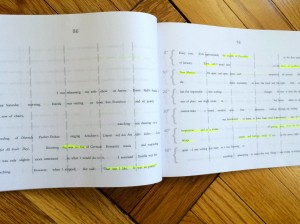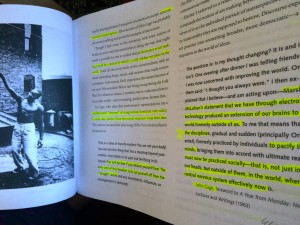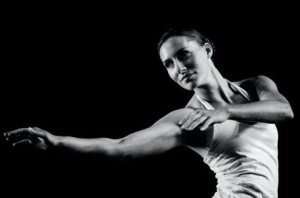It’s always interesting when one artist inspires another–especially when they operate in two different mediums.
Brock Clawson is a choreographer who has had work performed by both the Milwaukee Ballet and The Joffrey Ballet. Herbert Migdoll, artist, Director of Special Projects for Joffrey, and long-time company photographer, recently created a series of art pieces based on Clawson’s piece, “Crossing Ashland”.
We wanted to learn more about how the inspiration for this work came about, so we reached out to Mr. Migdoll to learn more about his process. (Please feel free to click on the photos below to bring up a larger view.)
What was it about Brock’s piece (Crossing Ashland) that you were drawn to specifically?
Initially, in the Joffrey dance studio, the work reminded me of the ballets performed at Judson in the Village in the olden days. That period included such artists as Carolee Schneeman, Laura Dean, Meredith Monk, Twyla Tharp, Cathrine Litz and many others. It always had a rawness and simplicity in the aesthetic, which allowed one to realize that all movement is a part of dance. The core came from rough ideas, and the motion of the dancers presenting those elements were indulged by an audience and relished by visual artists–like Rauchenberg who jumped into dance and even performed in a work with Steve Paxton there. A photo from that performance is on my list of paintings, TO DO.
The bodies of the dancers (in Brock’s piece) rolling to the left and then to the right is totally unique to how bodies are normally focused upon.
As a kid I loved to roll down low ravines or in the shallow waters of an ocean tide foaming onto the beach as the twilight of evening was approaching. All of this creates a visual plethora of ones past experience with rolling around. I knew fairly quickly that Brock had touched a nerve in my collective consciousness and that I would have to run with it. That electrical moment does not occur that often and when it does you are not able to not jump into the creative process.
God does good stuff too–like grass and human bodies seemed inevitable elements of collaboration. The grasses in Lurie Garden are often nifty, and also in Ping Tom Memorial Park.
Do you have a particular piece you gravitate toward?
The first grey panel I produced with colored bodies on top and flesh bodies below would be my first choice if I could afford to buy one. But I can’t.
Also the 5 bodies lost in the Lurie Garden autumn grasses is uniquely magical.
Bob Joffrey once remarked that wonderful art will always have a quality of being magical. It’s the magic that allows you to enter that other dimension.
What was your creative process like with this project?
It started by watching a rehearsal–and from that to know that I had to shoot a lot of rolling around stuff. And I did.
Then I edited down to nine iconic images and placed them mostly sequential order as they appeared on stage–but not strictly. Next I looked at them in Photoshop to eliminate the photographic aesthetic and coax the slickness out of the photo into an evolved
sort of drawing–and then to finally take shape into an acrylic reproduction–producing a digitally painted series of nine images in a row.
The monochromatic “drawing-like” figures were so on the mark, I stopped and simply continued to create an almost square of bodies which became a matrix for the possibility of endless modular combinations. And these compositions of modules will now continue on as long as I have funding to produce new canvasses.
The grey backgrounds on some of the works led to the beauty of colors against grey, and intermingled with the lush flesh colored bodies. All of which have nothing and everything to do with Brock’s ballet. Rothko, one of my heroes, inspired me to pursue the soft edge of one or two colors firmly blended and totally separate. It’s all kind of a “stream of consciousness” response–and finally a leaving of the source of inspiration. It is an acceptance that the inspiration is the golden source–not because it recreates the final images–but because it evolves art totally unique from the source.
Painting is not illustration. It’s something else!









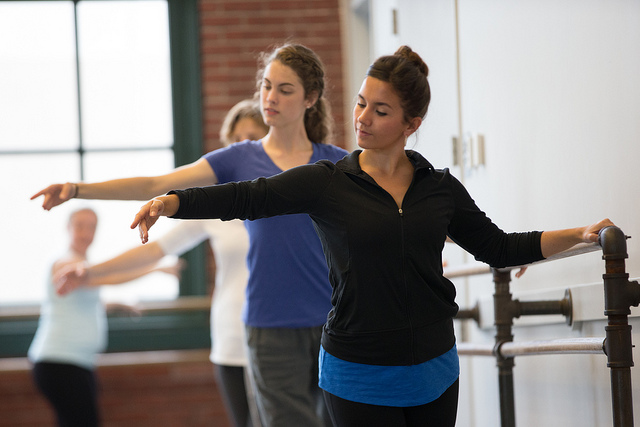
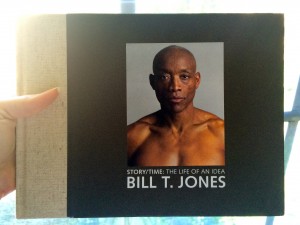 STORY/TIME is a three-part book that also serves as a companion piece to the Bill T. Jones/Arnie Zane Dance Company’s live production of Story/Time that will appear at New York Live Arts on November 4-8, 11-15 at 7:30pm. More information:
STORY/TIME is a three-part book that also serves as a companion piece to the Bill T. Jones/Arnie Zane Dance Company’s live production of Story/Time that will appear at New York Live Arts on November 4-8, 11-15 at 7:30pm. More information: 